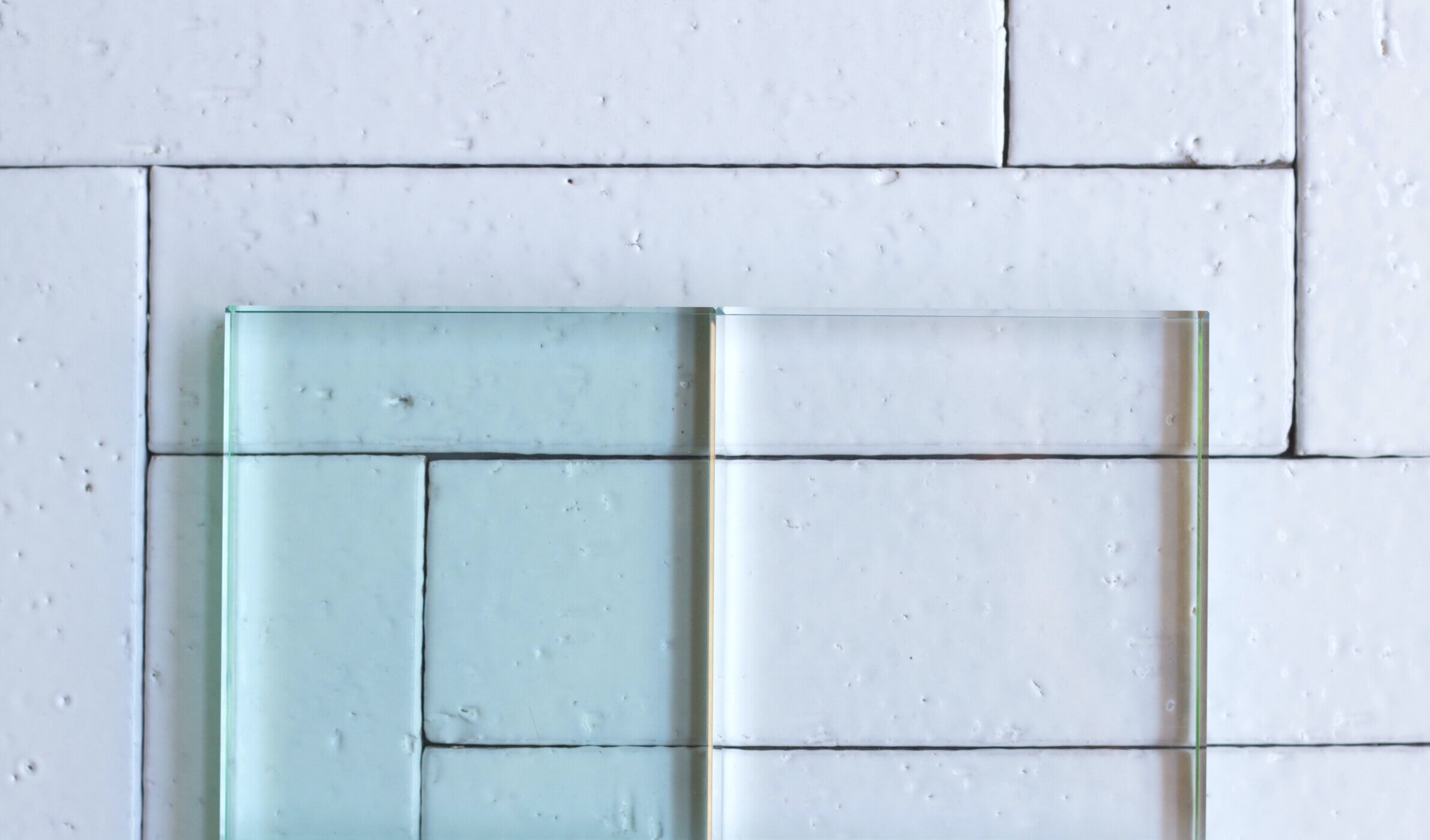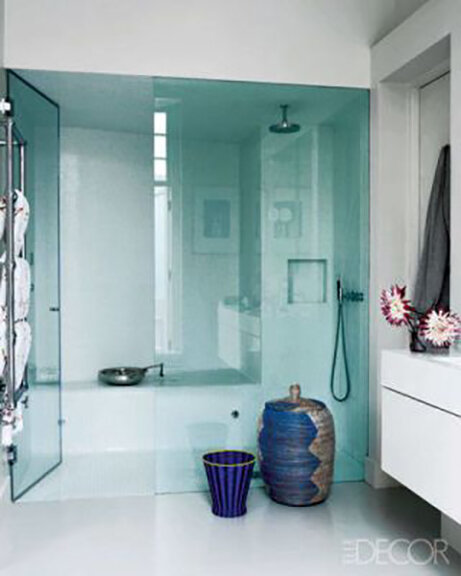Shower Glass: Clear vs. Low-Iron
Clear Glass (left) / Low-Iron Glass (right)
Wait a minute, what do you mean clear glass is not in fact clear? Isn't all glass clear? I have had the following discussion with each and every design client during a bathroom remodel. An often overlooked detail of a bathroom renovation is the transparency of your shower glass. Ideally, this discussion takes place in the early days of a project, but is often left until late in the process when clients are faced with decision and budget fatigue. So, by now you're wondering what in the world is the difference between clear and low-iron glass? Let's jump right in.
Clear Glass
Clear or Standard glass as it turns out is not the clearest glass in the market. Due to the iron content in glass, clear glass will appear to have a greenish tint. For a bit of background, glass is made by heating sand, soda ash and limestone; the naturally occurring iron oxide in the sand creates the greenish tint that we perceive in clear glass. A determining factor in the amount of green ultimately present in a space is how the glass will be installed. For example, a framed glass shower door would only require 3/16” or 1/4” thick glass as the metal frame will provide the structural support. Frameless shower glass typically requires a thickness of 3/8” or 1/2” because the glass is acting structurally. As the thickness of the glass increases the greenish hue will become more pronounced.
With that being said, shower glass takes up a fair amount of vertical space in a bathroom, so it’s worth being treated as a true design element in the space. Take a look at the following examples for a few instances of clear glass being used to enhance the design of the room.
If you’re installing a show-stopping green shower tile, standard glass might be the way to go. Just look at the stunning green marble shower, the tint of the glass beautifully highlights and emphasizes the emerald tones in the stone.
Another thoughtful way to use standard glass is to highlight the glass as an intentional design element. The blue-green color of the glass helps to create a private spa-like shower retreat.
Clear glass can also help to create a visual hierarchy in a space while highlighting a functional element in the room. The slight hint of green in the glass helps to balance the weight of the vanity and height of the mirror on the opposite wall. If the glass were entirely transparent, the far right corner would lose it’s visual weight in the room and lead your eye to focus on the window and ultimately the toilet below.
Low-Iron Glass
If on the other hand you are installing a beautiful light marble, crisp white subway tile or textured plaster and want the shower surface material to be as vivid as possible, then opt for the low-iron glass. Low-iron or ultra-clear glass is created from sand with a very low iron content. This minimal amount of iron will give you the clearest glass possible, while allowing for the maximum amount of light to pass through the glass.
In the instance of a continuously tiled wall extending from the shower to the main bath space, low-iron glass keeps the tile colors consistent and vivid.
To maximize the length of a space, ultra-clear glass is a key feature in showcasing every inch of the area. The large and beautifully appointed shower above is the dominant feature in the room, if standard glass had been used, in this instance, the space would have been subtly divided into two separate zones. Instead the transparency of the low-iron glass allows your eye to read the full extent of the room.
When your main light source, whether windows or skylights or both, occur beyond the shower glass, low-iron glass will transmit the maximum amount of light into the space. Additionally, the ultra-clear glass will keep the space from being bathed in a wash of greenish light.
Ultra-clear, low-iron glass can be used to show off all of the hard work and effort that goes into picking the perfect marble or porcelain slab, adjusting the wall structure to create an oversized niche and choosing the perfect bold, but minimal shower fixtures.
Other names for Low-Iron Glass:
Extra-Clear Glass / Optically Clear Glass / Starphire By PPG / UltraClear by Guardian Glass / Optiwhite By Plikington / Clearvision by AGC / Krystal Klear by AGC
When ordering a custom shower enclosure, low-iron glass is on average 10 - 30% more expensive than standard glass. Also note the cost of low-iron glass can vary based on brand name versus generic and by fabricator. Due to this fact, it's best to decide on the type of glass you will be installing as early in the project as possible in order to build the cost of the glass into the construction budget.
So what happens if you love the look of low-iron glass, but the additional cost will exceed your budget? Take a look at the current design, would it be possible to reduce the height of glass? Or, this one is a bit radical, do you need a door? More and more clients are asking for showers without doors or even a full shower enclosure.
If there is one-take away, shower glass is a large design element in your space. Ask your designer, architect, contractor or glass company for samples early in the design process, it may help to inform your final tile, paint, and material choices. At the very least you will know what to expect and can avoid any unwanted surprises after your glass has been installed. Consider this a shower glass PSA, the more you know…
To keep you’re newly installed glass clean, Sprayway is the best glass cleaner I’ve found to date. And, the natural option I’m planning on trying next is Aunt Fannie's Glass & Window Wash. For daily care, a shower squeegee can help to keep your glass spot-free.
Next up, Shower Door Handles + Knobs
*This post contains affiliate links, so I may earn a small commission when you make a purchase through links on the site at no additional cost to you.








